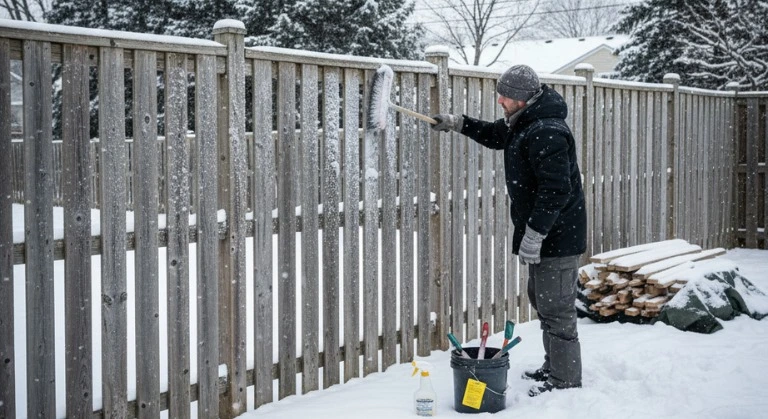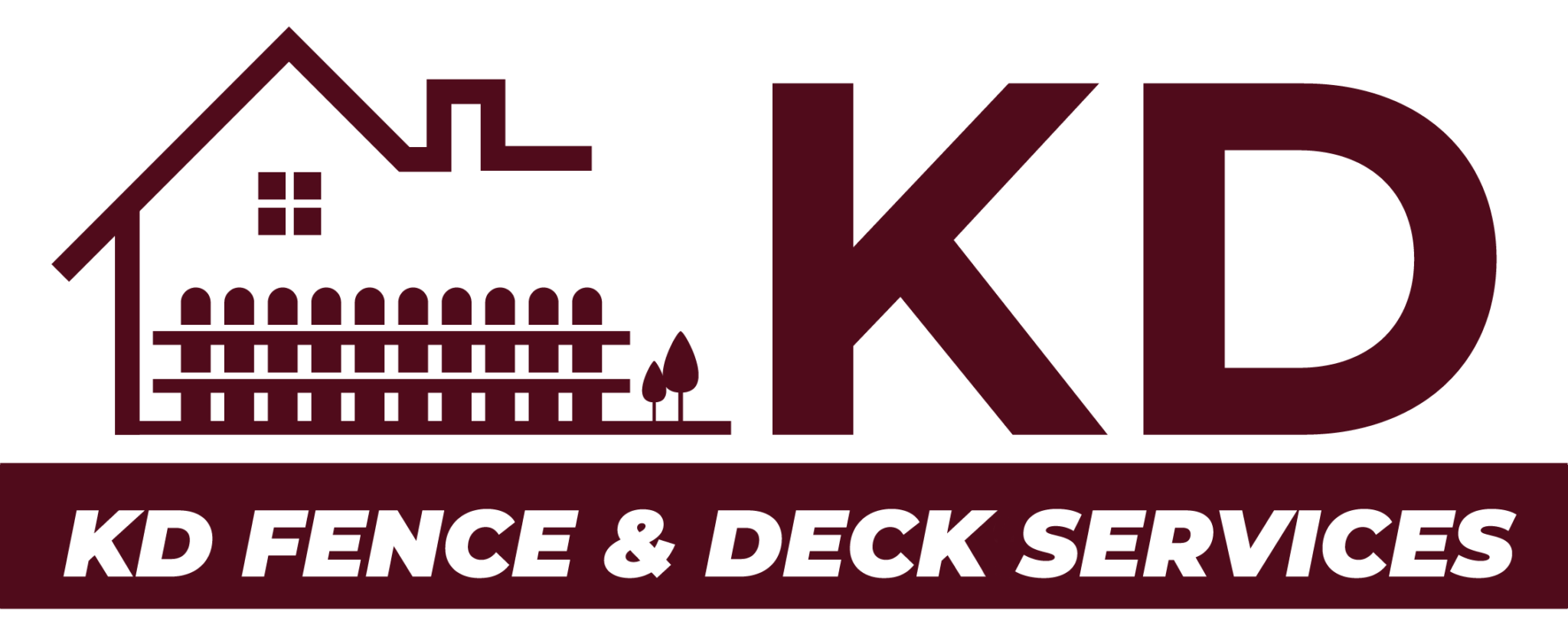The winter in Buffalo, NY, is gorgeous but harsh to all that comes outdoors, including a wooden fence.
Clarence, NY, Williamsville, NY, and Lancaster, NY, all areas with heavy snow, freezing temperatures, wind, and ice, cause havoc to the homes of people in Amherst, NY. This is where guidance in wood fence maintenance in Buffalo, NY comes in handy.
Is wood fence maintenance in Buffalo, NY, a necessity for a long-lasting fence? Yes, it is.
Let’s go through this step-by-step guide on fence maintenance tips in NY to help you see your investment through another season.
Let’s roll in!

Step-By-Step Guide for Wood Fence Maintenance in Buffalo, NY
1. Inspect and Stabilize Before the Cold Hits
Do not wait till the snows fly. Step up for wood fence maintenance Buffalo, NY,
- Stroll around your whole fence and look for cracks, splits, rot or loose boards. These are some of the weak areas that turn into disaster areas during freeze-thaw stress.
- Check posts and post footings. When one of the posts is wobbly, it is time to replace or stabilise it.
- Make sure that the trees and bushes near the fence are clipped so that they will not fall on the fence when weighted down by snow and ice.
- Clip the grass and shrubs immediately beside the fences. Long grass has moisture that penetrates the bottom boards, making it more prone to rotting of the fences during winter.
2. Wooden Fence Cleaning and Sealing: The Core of Winter Fence Care Buffalo
Forming a barrier between wood and moisture is one of the most essential strategies of wood fence maintenance Buffalo, NY.
Cleaning
Wondering how to protect a wooden fence in Buffalo? Then your first step is cleaning.
Start by sweeping away leaves, rubbish, and nests. Wash with gentle water pressure (or garden hose and scrub brush) to eliminate mildew, soils, and algae. Do not use excessive pressure that can cause softwood fibers to be damaged.
Allow the wood to completely dry, not less than 48 hours (more in high humidity). Any moisture caught under the stain or sealer is no good.
Sealing or Staining as a Weatherproof Fence Treatment
After drying, run a good quality of wood stain, paint or sealant that is suitable for exterior use. Sealing also helps in enhancing home curb appeal in Buffalo, as it won’t rot.
A significant number of professionals suggest semi-transparent stains since they allow wood to breathe and protect it.
Add a second coat where directed by the manufacturer. Maintain the barrier by re-sealing or restaining every 2-3 years (or before each heavy winter), which is very effective in outdoor fence upkeep.
Care for Wood Edges
Give special attention to the cuts on end grain, top of posts, and bottom of edges; these are points of entry of moisture. Vulnerable junctions can be sealed with a brush-on sealant.
This step provides huge bargaining power against winter weather fence protection.
3. Tips for Frost and Snow Damage Prevention Throughout Winter
Having the cold settle down, what you need is vigilance to make your fence survive and not merely endure.
Removing Snow Load to Prevent Fence Rot in Winter
Don’t wait until the snow is deep. A soft-bristle broom or plastic snow shovel can be used to push the snow off the top of the fence softly, moving outwards moving panel by panel. Metal tools that will gouge the wood should be avoided. Concentrate on places where the drifts can be lying (corners, windward sides).
Preventing Ice Adhesion
Bores can get boards disabled, or ice can form on the surface of the fence. Reduce the direct development of ice by.
Use of de-icing agent sparingly around the base (do not touch the wood).
Covering the fence line with snow fences or wind break panels so that drifting snow does not cover the fences.
Covering especially vulnerable areas (where snow is likely to accumulate on tarps) temporarily in freezing rain or sleet with breathable tarps (be careful of the weight of snow on the tarps).
Monitoring Stress
After a snowfall, make sure there is no additional sagging, shifting, or broken boards. Wood fence repair in Buffalo is slightly less costly and easier if it is detected early.
4. Prevent Fence Rot in Winter with Drainage and Moisture Control
Ground moisture is also a problem even during winter, and particularly at the end of your fence.
Grading and Slope
Make sure that your yard slopes are sloping out of the fence, thus avoiding the accumulation of meltwater at the boards. Defective grading will result in the accumulation of water and its saturation in the lower planks.
Gravel or Porous Strip
Place a strip of gravel bed or crushed stone (e.g., 6 -12 inches) at the bottom of the fence. Gravel enhances drainage and reduces physical contact between soil and wood.
Gutters, Downspouts & Runoff
When the roof runoff on your home flows close to your fence, force it out through downspouts or landscaping to ensure you do not have the water coming close to your fence. When a gutter is clogged, it may overflow and eventually run water by your posts.
Temporary Drain Trenches
It is impossible to walk off and hope. Checks in the middle of the season are worth taking.
Check gaps that opened up after warm spells or thaws. Sealant, caulk or weatherstrip should be reapplied where necessary.
5. Minor Wood Fence Repair in Buffalo, in Mid-Winter
You can’t just walk away and hope for the best. Mid-season checks are valuable because you can prevent full fence replacement with just a minor wood fence repair in Buffalo
- After warm spells or thaws, check for gaps that opened up. Reapply sealant, caulk, or weatherstrip if needed.
- Tighten screws or nails that could have been loosened by freeze-thaw cycles.
- Either substitute or repair any board with rot or splintering before it gets away.
- Clear off any ice or debris that may be pushing on the painted or stained ones.
In fences, Williamsville, NY, Amherst, NY, Lancaster, NY, Clarence, NY, etc., local circumstances may vary; inquire particularly of the windward side of the fence, whether the wind or the freezes have not damaged it.
The small adjustments made frequently are usually cheaper than the big repairs made on a later date.
6. Spring Thaw & Post-Winter Rehab
The first opportunity that comes is when the ground thaws, you have the spring to put back the full integrity.
- Clean the base and the fence of all snow, ice, and winter debris.
- Check cracks, splits, or warping that could have increased.
- Wash and, where necessary, re-stain or cover.
- Check post footers and recheck those that moved.
Plant or promote grass and vegetation on which the bottoms of the fences are not in direct contact to avoid retention of moisture.
It is a post-winter service which will reset your fence to grow in the seasand which will check the upkeep of outdoor fences into summer.
KD Fence: How We Help You in Winter-Proofing Your Fence
We are well aware of the harsh climate in Buffalo at KD Fence. Our group will offer professional winter weather fence protection to fit the wood fence maintenance buffalo NY, and its neighboring places such as Amherst, Clarence, Williamsville, and Lancaster.
We do complete seasonal check-ups, power wash and re-seal your fence, repair wobbling posts, and do any wood fence repair Buffalo requires before the next winter sets in. You benefit by cooperating with us.
- You can get weatherproof fence treatments from us.
- Quality preventative health and emergency response.
- We will guarantee a durable fence that lasts for decades.
Read our friendly blog on how to winterize your fence and deck for more tips on Weatherproof fence treatments
Summary Table: Winter Weather Fence Protection, Checklist
Use this table as your seasonal blueprint to keep your wood fence performing year-round.
| Stage / When | Key Tasks | Purpose |
| Late Fall (before freeze) | Examine, trim, straighten posts, and mow grass. | Maximize strong points and risk definition. |
| Pre-winter (dry period) | Wipe, dry, and seal with oak stain/charcoal stain to prevent fence rot in winter | Create a moisture barrier |
| Mid-winter | Clearing of snow load, discouraging ice, stress observation, and small-sized repair. | Avoid doing harm before it exacerbates it. |
| Drainage control | Regrade, Rework soil, apply gravel, redirect soil, trench where necessary. | Keep the base dry and avoid rot |
| Post-thaw / Spring | Clean, re-check, re-stain, re-settled shifted posts. | Restore integrity for the next cycle |
CTA
Don’t wait until your fence shows damage. Winter is coming! Protect your investment with proactive care and expert support from KD Fence. Reach out today at KD Fence & Deck Services or call (716)452-9220 to schedule a winter-proofing consultation or maintenance service.
Frequently Asked Questions
What is the frequency of reapplication of stain or sealant?
Semi-transparent stains are a common occurrence every 2-3 years, depending on the transparency of the area (Buffalo, NY weather). It is best to install winter weather fence protection before each severe winter.
Is it possible to operate a pressure washer frequently?
Yes, but gently. Apply moderate pressure and a wide spray nozzle so as not to gouge the wood. Proceed with drying, then seal it.
What is the most appropriate way to stuff the cracks or gaps?
Outside grade wood filler/caulk made to withstand the outside. To cause greater destruction, change the part of the boards.
Will KD Fence fix my fence, which was ruined due to winter?
Absolutely. We deal with wood fence repair in Buffalo, which is a full line of our maintenance and restoration.
What different places serve KD Fence best in the vicinity of Buffalo?
Our location mainly covers the areas of Buffalo, NY, Amherst, NY, Clarence, NY, Williamsville, NY, and Lancaster, NY.
